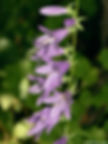Creeping Bellflower
- May 22, 2021
- 4 min read
Updated May 22, 2021
Take a drive around our Twin Cities’ neighborhoods. The second most common weed you will see is Creeping Bellflower (Campanula rapunculoides). The yellow dandelion is more common, but this bellflower must be close behind.
Creeping Bellflower came to us by way of Europe and western Siberia. With beautiful lilac bells adorning the stem, it was originally brought to North America as a colorful ornamental to plant in perennial gardens. It is a very pretty, very hardy, and very tough perennial, and a noxious weed. It is often found in garden settings, but it has escaped into natural areas like grasslands and stream borders.
Creeping bellflower has become a noxious weed. It loves moist soil but can grow in drier soils in sun or shade. Even
if there is a tiny bit of soil in a sidewalk crack, Creeping Bellflower will feel at home. A single plant produces from 3,000 to 15,000 seeds, and little wings on the seeds help it disperse by wind. Creeping bellflower roots spread rapidly and become entangled with roots of other perennials. Even dropped leaves can set root and sprout. In a few years, Creeping Bellflower can take over a garden or lawn and choke out other plants.
Some sources suggest planting this flower where nothing else will grow. There are Creeping Bellflower seeds for sale on the internet and a few nurseries carry it. If you buy a wildflower mix, check to see that this pest is not included. DO NOT EVER PLANT THIS PLANT ANYWHERE! Creeping bellflower may be happy in a remote spot, but eventually it will escape by seed or roots to infest a new area and will choke out native vegetation.
Recognizing Creeping Bellflower
Information from the University of Wisconsin Extension:

Beautiful, lavender/purplish-blue, 1-inch, bell-shaped flowers with 5 lobes from June to September along one side of the flowering stalk.
Stalks can grow up to 3 feet tall and produce a milky sap when broken.
Purple stem at the base.
Alternate leaves.
At the base, heart-shaped leaves connect to the stem by a stalk.
Leaves are toothed, hairy on the underside.
Upper leaves are elongated, lance-shaped, and are connected directly to the stem; no stalk is present.
Creeping Bellflower has three (3) types of roots:
Lateral rhizomes that give rise to new plants.
Long, deeply buried, carrot-like vertical storage roots that store energy for winter survival.
Fine roots that branch off of the other two types.
Similar-Looking Plants
Campanula rapunculoides is sometimes confused with our desirable, pollinator-friendly native bellflower called Harebells (Campanula rotundifolia). (image far left).
Ladybells (Adenophora liliifolia) (image immediate left) is closely related, is very similar in appearance, and is better behaved than its cousin. Sometimes, nurseries will mistakenly sell Creeping Bellflower instead of Ladybells.
Controlling Creeping Bellflower
Removal
Organic control of this pest is to dig it out completely. Do not try to PULL it out! With its extensive root system, even if a tiny root fragment is left behind while weeding, a new plant pops up. The roots are very brittle and it is easy to leave some small roots behind; these will grow into new plants. To exhaust the root system, loosen the soil around the plant with a garden fork. Then dig at least 9 inches deep with a trowel to remove as many lateral roots, tubers, taproots, and root fragments as possible.
During the growing season, keep digging up any new plants that appear later. Parts of the root system can remain dormant for over a year. Unfortunately, some gardeners report that it has taken up to five years of persistent digging to entirely remove this pest. Eventually patience and persistence pay off. Dispose of plant parts into the trash; composting may not kill the plant and re-infestation could occur.
Smothering
Smothering with newspaper, cardboard, and a mulch may work. Solarizing the soil with a black plastic mulch is another option. These methods take time and are not fool proof. Small plants may still pop up even after lengthy covering.
Remember to remove any remaining, flowering stalks before they can set seed.
Herbicides
I do not like to use industrial pesticides on my garden, but with creeping bellflower I can make an exception.
Creeping bellflower is resistant to 2,4-D. Glyphosate-containing herbicides like Roundup® work for spot treatments, but repeated applications at 7–10-day intervals are usually necessary until new sprouts are gone. Triclopyr-containing herbicides will work on your lawn and will not damage the grass; use repeated treatments. Clopyralid-containing herbicides (like Stinger®) have proven best for control of Creeping Bellflower. Effective control has also been achieved with Garlon 4 in oil spritzed on cut ends of the roots.
For all herbicides, treat in late spring and early fall when temperatures range between 60 to 85 degrees Fahrenheit. The air should be calm, and rain should not be forecast for a few days after applying. Be very careful to follow package instructions exactly, take precautions to protect yourself while using, and shield desirable plants from herbicide drift. One gardener has reported success by spraying Creeping Bellflower just before the flower stalks form.
Best wishes in removing this noxious weed, and Happy Gardening!

Joe Baltrukonis
Ramsey County MASTER GARDENER


